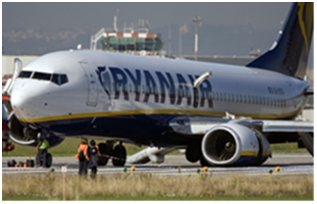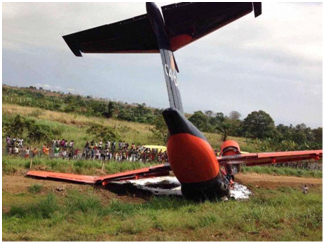 it
it  en
en
Archive 2018
This website has been operating in the field of wildlife strike prevention since 2007 and over the past twelve years has tried to provide not only the news collected in the specialized press, but also comments, observations, articles, in other words all that contributes to increasing the culture of safety in this particular area.
In particular, we believe that we have played, and still play, a useful role by publishing all the known Court judgments about the wildlife strike events, and by presenting the investigation reports issued by the various world authorities following accidents.
Since the last three years, the frequency of updates has been quarterly, a choice made mainly to contain the costs of maintaining and updating the website, which does not receive advertising nor any kind of financial support.
With this choice, however, we also intended to favour the quality of information, albeit at the expense of timeliness.
We take the opportunity to wish our readers a Happy New Year.
The Italian ANSV released the final report on the accident that occurred on 10.11.2008 to the Ryanair B737 EI-DYG aircraft at Rome Ciampino airport. Since the report has been published immediately before the last update of this newsletter, possible comments will be available in the first update of 2019.
The Investigation Committee appointed by the BAGAIA (Banjul Accord Group Accident Investigation Agency) has released the final report on the accident that on 29.07.2017 involved an Antonov An74-100 of the Ukrainian company Cavok Air. It was an accident where the impact with birds played a significant role; we therefore decided to thoroughly analyse the results of the investigation and to formulate our observations in a specific document.
We attended the recently WBA conference. For our meeting report, see here.
All the presentations can be downloaded from the WBA website (www.worldbirdstrike.com )
Two dual ingestions characterize the fourth quarter. Although there are still those who define the dual ingestion as a rare event, two episodes in few days (November 5 and 24), and in two different continents, remind us how the problem has to be taken into consideration now also by a statistical point of view.
In the first case, both engines of a twin-engine ingested birds, which damaged some of the fan blades but did not affect the inner cores.
In the second, the ingestion of medium-sized birds (Crows) occurred into the engines no. 3 and 4 of a Boeing 747, therefore on the same right wing. It must also be noted that the event took place during the take-off phase of a long-haul cargo flight, so we can assume that the aircraft was quite heavy. Even the emergency management does not appear linear: the pilots first decided to land immediately, but then went around at 1000 ft. to reach the open sea and discharge fuel, and finally returned hastily to landing as the engine no. 4 had begun to show remarkable vibrations.
Both cases were high-risk events that pose the usual problems: on one hand, the need of reconsidering the certification requirements, and on this side something is happening at FAA and EASA. On the other, the training of flight crews with respect to such frequent events whose consequences are difficult to predict. In addition, the need to adopt early warning and remote sensing systems at airports, such as the avian radars that in a few years have reached smaller and smaller size and costs.
- 1 October – Sochi (Russia)
UTAir B737, suffered a bird strike on departure, which damaged a sensor affecting the gear retraction; the crew decided to divert to Krasnodar where the aircraft landed 65’ after take-off; - 1 October – New York (La Guardia)
Delta A319, during the initial climb the crew declared emergency stating they hit “something really large” and diverted to JFK requesting emergency services be on standby; - 2 October- Barcelona
Norwegian Air Shuttle, B787, returned to land after reportedly suffering a bird strike after takeoff. The aircraft dumped fuel over the Mediterranen Sea before landing back at Barcelona, 70 minutes after departure.
https://aviation-safety.net/wikibase/wiki.php?id=215972 - 3 October – Islamabad
Thai Airways A330, on approach a bird impacted the aircraft causing a windshield to crack; - 5 October – near Dallas (TX)
bird strike climbing through FL 180; the crew decide to continue the flight till destination; - 6 October – Sacramento (CA)
Air Transport International B767, during the initial climb the aircraft struck a bird and landed back; minor damage; - 9 October – Cleveland (OH)
Allegiant A320, bird strike at departure; in the absence of abnormal indication the crew decided to continue the flight till destination; the aircraft received unknow damage and has been grounded for more than two days; - 12 October – Atlanta (GA)
Sky Regional Airlines ERJ 175, on approach descending through 3500 feet MSL the crew heard a bang; shortly afterwards the thrust started to increase. The crew disconnected the autopilot and manually reduced the thrust to the correct settings; a post flight inspection found a dent and remains of a bird just forward of the ADS probes on the right hand side of the nose, there was debris in the ADSP4 probe. - 15 October – Geneva
Swiss International BCS 300, was climbing out through FL380 out of Geneva when the crew decided to return to Geneva due to a bird strike. The aircraft landed safely back about one hour after departure.The entire aircraft rotation was cancelled. - 17 October – Lampedusa (Italy)
Vueling A320, bird strike during the approach; return flight delayed by almost 24 hours; - 19 October – Sumburgh (UK)
Loganair Saab 2000, climbing through 1500 ft. a bird impacted the left hand engine. the crew decided to land back about 20 minutes after departure; - 23 October – Williamsport (PA)
Piedmont ERJ 145, struck a deer on the runway and rejected take-off; flight cancelled; - 25 October – New York (JFK) or London
British Airways B747, after landing at London an inspection revealed an impact with a bird;
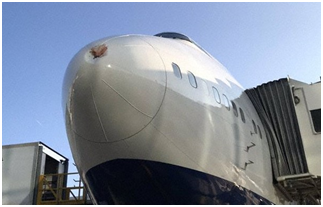
(Photo: Stu; taken from Avherald.com) - 1 November– Madrid
Iberia A320, during the initial climb the right engine ingested birds that caused five bangs; immediate return about 15’ later with only one engine; - 4 November – Erbil (Iraq)
Iraqui Airways B737, in the initial climb the aircraft flew through a flock of birds and received multiple impacts as well as ingested a number of birds into the left engine prompting the crew to land back about 13 minutes after departure. Several impact marks were seen on the leading edge of the left wing. - 4 November – Mahe (Seychelles)
Joon A340, during the initial climb the #3 engine developed vibrations prompting the crew to reduce the engine to idle thrust, stop the climb and land back; a post flight inspection revealed 4 fan blades damaged, supposedly because of a bird strike; - 5 November – Calgary
Air Canada A319, during the initial climb the aircraft flew through a flock of birds and sustained a number of bird hits. The crew landed back about 10 minutes after departure.
A post flight inspection found two fan blades of the left hand engines well as a dent at the engine inlet leading edge, in addition 7 fan blades of the right hand engine were found bent. Both engines revealed no internal core damage in borescope inspections. - 7 November – Sacramento (CA)
Napa Jet Center Cessna 525, multiple bird strike on final; - 7 November – Okayama
All Nippon Airways A321, rejected take-off at high speed (90 kts.) further to the ingestion of a bird into the left engine; - 9 November – Dusseldorf
Laudamotion A320, during the climb after take-off at FL210 the left engine developed vibrations probably due to a previous bird strike; the crew landed back about one hour after departure; - 14 November - Pittsburgh (PA)
Southwest B737, during the initial climb the aircraft flew through a flock of geese and suffered a number of bird strikes. The crew stopped the climb and landed back 25 minutes after departure.
A post flight inspection revealed a large hole in the right hand horizontal stabilizer with a goose hanging down.
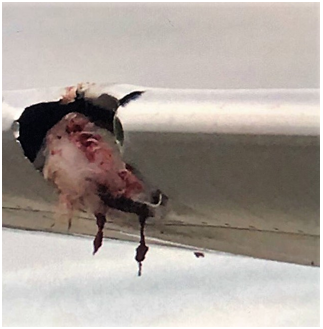
(The goose embedded in the hole caused by the impact; Photo by Christine Florijan taken from aviation-safety.net) - 17 November – Salt Lake City (UT)
Delta B767, during the initial climb the aircraft flew through a flock of large birds and the right hand engine ingested at least one of them. The crew landed back immediately about 12 minutes after departure. One of the birds was hanging out of the right engine's bypass duct.
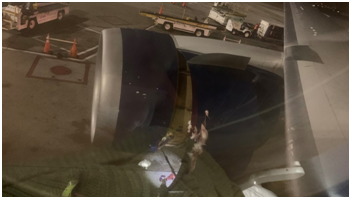
(Dead pelican in Delta plane engine; Photo by Jennifer Newman taken from Kutv.com) - 22 November – Cape Town
Comair B737, during the initial climb an engine ingested one or more birds; immediate landing back 25’ after take-off; a number of fan blades were bent; - 23 November – Bucharest
Ryanair B737, bird strike on final; an inspection revealed fan blade damage to one of the engines, the aircraft was unable to continue its schedule;
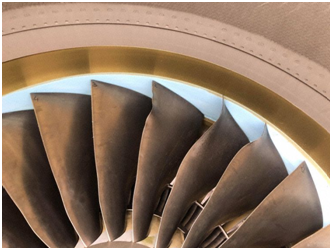
(Fan blade damage; Photo: boardingpass.ro taken from Avherald.com) - 24 November – Boston (MA)
American Airlines B737MAX8, bird strike at take-off, immediate return 10’ later; - 24 November – Liegi
ASL Airlines Belgium B747 was climbing out when the aircraft flew through a flock of crows, engine #3 as well as engine #4 (both in the same right wing) ingested a number of birds prompting the crew to stop the climb and perform an instant return to Liege. The aircraft was on final approach when the crew initiated a go around from about 1000 feet AGL, subsequently climbed to FL160 and headed out over the North Sea to dump fuel. Engine #4 developed vibrations prompting the crew to again return to Liege immediately. - 25 November – San Francisco (CA)
Eva Air B777, during the initial climb the crew reported they had a left hand engine failure. The crew shut the engine down and dumped fuel, then landed back about 50 minutes after departure;
https://www.taiwannews.com.tw/en/news/3583849 - 25 November – Austin (TX)
Allegiant A320, bird strike at take-off causing vibrations at the right engine that continues to run however; the crew landed back 35’ later; - 27 November – Sacramento (CA)
Compass ERJ175, bird strike on final approach; return flight cancelled; - 28 November – Istanbul (Ataturk)
THY B737MAX, during the initial climb suffered a bird strike prompting the crew to land back about 80’ later; - 1 December – Dallas (TX)
on final approach a bird impacted one of the pitot probes causing the loss of associated airspeed indication; the crew initiated a go around and landed about 22 minutes later. - 3 December – Dusseldorf
Ryanair B737, in the initial climb a bird impacted the left hand pitot tube resulting in disagreeing airspeeds; the crew then diverted to Cologne landing about 60 minutes after departure; the aircraft was unable to continue the flight; - 6 December – Sacramento (CA)
Southwest B737, bird strike at 2000 ft. during the approach; two birds hit an aircraft side; the aircraft was unable to continue the flight; - 9 December – Mwanza (Tanzania)
Precision Air Services ATR72, during the landing or immediately after the aircraft flew or rolled through a flock of birds and received multiple bird strikes causing the visibility through the windshield to be substantially reduced. A runway inspection showed countless bird remains on the runway surface. A post flight inspection revealed countless bird strikes to the nose and windshield, there were feathers around all pitot tubes, birds embedded in the landing gear and in both engine inlets.
https://www.thecitizen.co.tz/News/-Precision-Air-plane-collides-with-birds--but-lands-safely/1840340-4890182-format-xhtml-bq9pgr/index.html
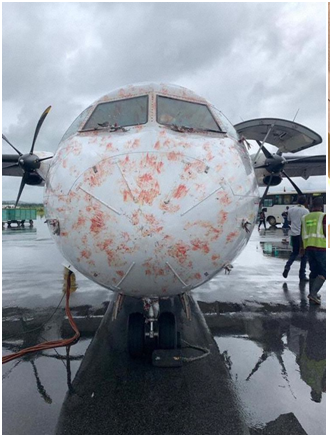
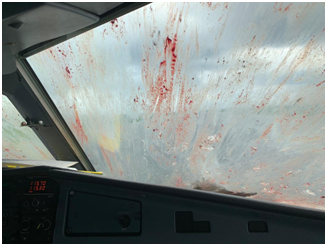
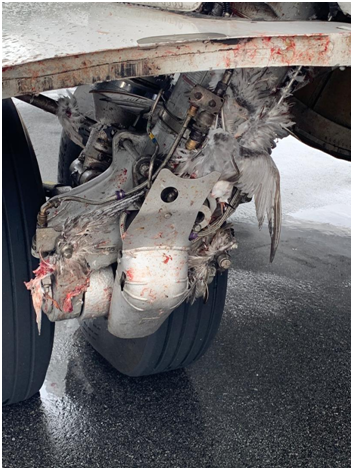
(The ATR after the multiple impact; photo Aviation Tanzania taken from Avherald.com) - 15 December – Hilo (HI)
Hawaiian Airlines B717, bird strike on approach; - 18 December – Amsterdam
Arabia Maroc A320, during the initial climb the crew reported they had multiple bird strikes and their engines were vibrating. Then the crew reported that their engines were operating normally although with vibrations and later confirmed they had a bird strike only into the right hand engine but the readings of the engine were still good. The aircraft landed back about 25 minutes after departure. - 28 December – Port Elizabeth (Sudafrica)
Comair B737, during the landing roll the right hand engine ingested a heron; the exact bird species is unknown;
The NTSB of the United States released on 5.9.2018 the final report on the event occurred on 10.11.2011 to a Delta Airlines A320 in Minneapolis; the report followed the first information released on 11.8.2018. Incidentally, the event, quite serious, was so far unknown. This reinforces the widespread belief that the known impacts are only a small part of the total.
The Italian press (La Repubblica) recently quoted an article published by four researchers of the California Institute of Technology, entitled "Robotic Herding of a Flock of Birds Using an Unmanned Aerial Vehicle". Readers can download it here
- 1 July – Sari (Iran)
Caspian MD83, at take-off the left engine ingested a number of birds; landing back 55’ after take-off; - 3 July – Chennai (India)
Jet Airways B737, on final a bird impacted the left engine; - 4 July – Sialkot (Pakistan)
Emirates B777, on final an engine ingested a bird; the aircraft was unable to perform the return flight; - 5 July – London (Southend)
Easyjet A319, during the initial climb an engine ingested a bird; the crew decided to land back at Stansted 18’ later; - 6 July – Istanbul
MEA A320, bird strike during the initial climb; the crew decide to land back 20’ after take- off; the flight was rescheduled for the following day; - 6 July – Bergamo
Ryanair B737, the left engine ingested a bird at the rotation; immediate return 20’ after take-off; - 10 July – Nashville (TN)
Mesa Airlines CRJ700, on approach struck a large bird; the aircraft was unable to depart for the return flight; - 13 July – Singapore
ANA B787, during the landing roll the right engine ingested a number of birds; return flight cancelled; - 19 July – Dublin
Norwegian International B737, a bird strike at take-off prompts the crew to stop the climb, burn off fuel and return to Dublin; the aircraft landed back about 4:40 hours after departure; - 19 July – Washington (DC) (or Vienna)
Austrian B767, after landing in Washington a post flight inspection revealed a bird had impacted the right hand engine's inlet causing a dent; the aircraft was unable to perform the next flights that have been cancelled; - 19 July – Paris (CDG)
Air Transat A330, during the initial climb the right engine ingested a bird prompting the crew to perform an overweight landing; one fan blade damaged;
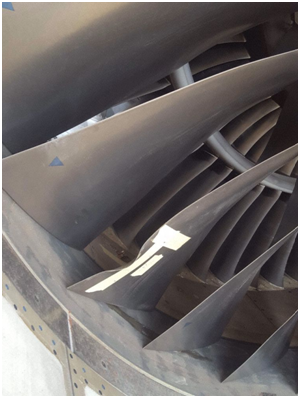
(The damaged fan blade; photo taken from Avherald.com) - 23 July – Chennai
Air India B787, on final approach descending through about 400 feet a bird impacted the nose of the aircraft that was damaged disabling the aircraft to perform its next scheduled flight; - 25 July – Punta Gorda (FL)
Allegiant A320, during the initial climb the crew reported a suspected tyre blowout and diverted to Orlando; later on bird remains were found in one of the engines; - 29 July – Nantong (Cina)
Kunming Airlines B737, after landing a post flight inspection revealed a hole at the leading edge of the vertical stabilizer caused by a number of bird strikes while turning final; the aircraft was unable to depart for the return flight;
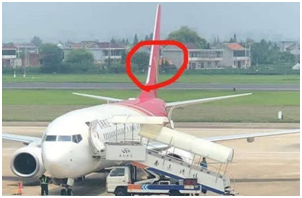
(Photo taken from Avherald.com) - 31 July – Lviv (Ukraine)
UIA B737, during the initial climb a bird impacted the left engine; in the absence of abnormal indications the crew continued the climb but later decided to divert to Kiev where landed about 3:15 hours after departure; no serious damage reported; - 4 August – Bruxelles
Brussells Airline A320, during the initial climb an engine ingested a bird; immediate return 40’ after take-off; - 6 August – Portland (OR)
Endeavor CRJ 900, after landing the crew reported a bird strike; damage to the left wing; - 6 August – Hyderabad
- Saudia Arabian Airlines A330, on landing struck a bird; the aircraft was unable to perform the return flight;
- 6 August – Munich
Lufthansa Cityliner CRJ 900, bird strike during the approach; the aircraft was unable to perform its next flight; - 7 August – Iguazu (Argentina)
Andes B737, during the final approach a bird impacted and penetrated the bottom part of the radome; the aircraft was unable to depart for the return flight OY-571; 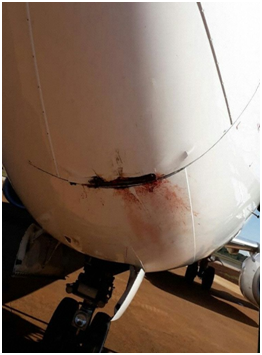
The hole in the radome; photo taken from Avherald.com)- 8 August – Churchill (Canada)
Nolinor B737, was accelerating for takeoff when the crew observed numerous Canada geese fly over the runway and rejected takeoff at about 120 kts. The aircraft collided with a goose however; the crew set the park brake to assess the situation before returning to the apron. Upon releasing the brakes, the crew noticed the brakes had seized. Emergency services were called out to inspect the landing gear and found both tyres on the left main gear had deflated due to the melting of the fusible plugs disabling the aircraft on the runway that remained closed for 10 hours. - 12 August – Alghero
Blue Air B737, during the take-off run struck a bird with suspected ingestion into an engine; the crew decided to land back about 15’ after take-off; - 14 August – Buenos Aires (Aeroparque)
AerolineasArgentinas B737, during the initial climb an engine ingested a bird prompting the crew to burn off fuel and land back about one hour after take-off; the whole rotation was cancelled; - 17 August – Barcelona
Iberia A319, rejected take-off due to the ingestion of a number of ducks in the left engine; flight cancelled; - 18 August – St. Louis (MO)
Delta B737, after take-offthe crew issued a pilot report stating there was a large flock of birds on the runway, but they were looking good. A few seconds later, the crew advised they would need to come back, as they had just hit a lot of birds. The aircraft landed back about 10 minutes after departure. - 19 August – Cedar Rapids (IA)
Allegiant Airlines A2320, bird strike on landing found out after an inspection; the aircraft was unable to perform its next flight; - 22 August – Orlando (Sanford) (FL)
Allegiant Airlines A320, during the initial climb the crew reported they took a bird on departure and needed to return, then advised they were too heavy for an immediate landing and did have high vibrations though; the aircraft landed about 30 minutes after departure; - 23 August – San Francisco (CA)
United B787, in the initial climb the crew advised they had about 4-5 bird strikes on departure; after a first decision to continue the flight, they advised they wanted to return to San Francisco as were concerned about the integrity of the airframe; the aircraftlanded back about 80 minutes after departure; - 25 August – between Vienna and Hamburg
Austrian A320, after landing the aircraft was unable to depart forthe return flight due to a bird strike; flight cancelled; - 27 August – Anapa (Russia)
Red Wings A321, a post flight inspection revealed the aircraft had received a bird strike to the radome requiring its replacement; the aircraft was unable to continue its schedule; - 29 August – Saint Vincent
Caribbean Airlines B737, bird strike during the initial climb that prompted the crew to divert to another airport; - 29 August – Davao (Philippines)
PAL Express A321, rejected take-off at high speed due to bird ingestion in the right engine; flight cancelled; - 29 August – Cancun (Mexico)
Viva AeroBus A320, collision supposedly with a bird during the initial climb that prompted the crew to land back;
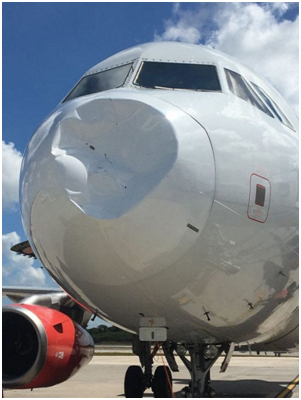
(The reshaped nose cone seen after landing; photo taken from Avherald.com) - 3 September – Newark (NJ)
American Airlines B737, bird strike with ingestion into the left engine during the approach; the aircraft was unable to fly the next leg; - 4 September – Faisalabad (Pakistan)
PIA A320, bird strike on final that damaged the radome; - 10 September – Palma de Mallorca
Eurowings Europe A320, during the take-off run an engine ingested a hare; immediate return 35’ after take-off; - 10 September – Denver (CO)
Frontier Airlines A320, hit a bird immediately after take-off; initially the crew decided to continue the flight but later landed back after having burnt off some fuel; - 11 September – Lamezia Terme
Easyjet A319, during the initial climb flew through a flock of birds, the left hand engine ingested a number of birds prompting the crew to shut the engine down and land back about 15 minutes after departure; - 14 September – Ostend
TUI Airlines Belgium B737, bird strike at take-off that prompted the crew to divert to Brussels about 30’ later; - 16 September – Algiers
Air Algerie A330, during the take-off run an engine ingested a bird; the crew rejected take-off at high speed, close to V1; - 17 September – Kathmandu (Nepal)
Saurya Airlines CRJ 200, during the initial climbthe left engine ingested a bird; the crew did not immediately realize the nature of the event and, in the absence of abnormal indications, decided to continue the flight to destination; however, about half way into the flight the left engine began to develop vibrations. A dead bird was found on the runway after the departure. A post flight inspection revealed two fan blades of the left engine were damaged requiring repair. As the airline owns only two aircraft and the other one was currently in maintenance, they needed to cancel all the flight of the day; - 18 September – Madrid, Iberia Express A321
during the initial climb struck a bird; in the absence of abnormal parameters the crew decided to continue the flight but was forced to land back when they realized that the aircraft received damage to the left flap track fairing;
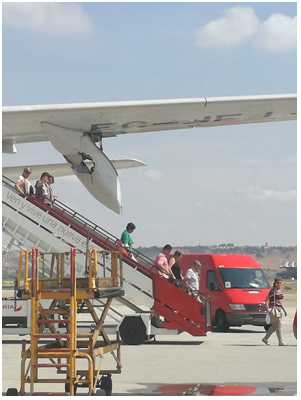
(Photo taken from Avherald.com) - 20 September – Malta
Air Malta A319, rejected take off at high speed (100 kts.) further to an impact with a flock of birds on the runway; - 21 September – Philadelphia (PA)
Delta MD90, bird strike at rotation; the crew decided to continue till destination; after landing unknown damage found; - 22 September – Jackson (MS)
Delta B717, during the landing at about 100 ft. received a bird strike on the radome; - 24 September – Riga
Air Baltic BCS300, bird strike during the approach; - 25 September – Riga
Air Baltic BCS300, hit some birds during the initial climb; immediately after the crew decided to land back; further to an inspection the aircraft was declared unfit to fly;
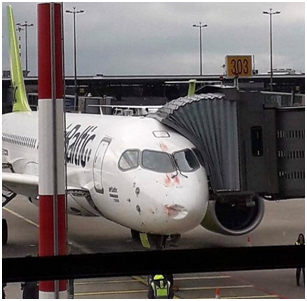
(Photo: GintsFeders, taken from Avherald.com) - 26 September – Trieste (RonchideiLegionari)
Alitalia A320, during the initial climb out the aircraft flew through a flock of birds and experienced a jolt prompting the crew to land back about 11 minutes after departure declaring that birds that had hit both engines;
A couple of months ago we published a worried article (see here the English translation) on a local online newspaper further to the release of a relevant number of griffons inside a natural reserve, but within the radius of 13 km. from Alghero airport. The ENAC initially denied the authorization, needed by the art.711 of the Navigation Code, but later negotiated with the project promoters and approved it although in a smaller scale. Many comments then followed, mostly supporting the article, posted even by very authoritative sources.
After time, and with many of the controversies that followed the article being calmed down, we wish to return to the issue to comment on some aspects that we deem significant.
“Le leggi son, ma chi pon mano ad esse?"(Laws there are, but who set hands to them?)wrote Dante Alighieri in the XIV century, and actually the first disconcerting observation was that nobody knew the articles 707 and 711 of Nav. Code and the limitation maps provided therein. Not the project promoters, not the Europe that funds them, nor any of the many authorities who, seated around a table, approved the project without moving any remark. Not even the local municipality that holds those maps and even makes them available for the public on its official website.
How many towns close to airports are in this situation? How many local authorities ignore the problem? We would like to know the opinion of ANCAI (National Association of Italian Airport Municipalities) on this issue.
The second question is, in our opinion, even more disconcerting and regards the opening of a negotiation between the Aviation Authority and the project promoters. The result was a watered-down compromise (14 griffons instead of 60) but this is not the point. The point is that a dangerous precedent passed, that even in the field of flight safety a negotiation is possible, and that therefore in aviation there are matters that are no more non-negotiable. In this case, we are talking about a waiver to the regulation that ENAC itself issued and the concrete increase of the risk index that the airport had laboriously reduced.
Why ENAC reneged on its negative opinion? Actually, reliable rumors speak of aEuropean funding of about two million euros, not to mention the international loss of face in the case of a project rejected due to the ignorance of the primary legislation by public bodies, universities and various other administrations.
It is therefore not difficult to suppose that significant forces and powers have moved to push to the classic Italian-style solution.
However, if yesterday we have had a negotiation on the number of griffons, who can tell us that tomorrow it will not happen again for landfills, or livestock, or intensive farming and any other attractive sources near an airport?
Let’s hope in an isolated case.
The ANSV (Italian Agency for Flight Safety) recently released the 2017 report on its activities and on the state of safety in the Italian civil aviation. In this report, as well as in that of 2016, bird strikes are not mentioned as an issue that affects safety. The ANSV justifies this choice by the fact that the Agency takes into consideration only the impacts that have actually caused damage to aircraft.
However, in at least one case there was an actual damage to an aircraft: on 28 January 2017 a B777 of Pakistan International Airlines landing at Malpensa suffered a slight damage to the tail due to the impact with a bird "or other object "(a bird or some other object impacted shortly before landing in Milan and caused minor damage to the aircraft, source: Avherald.com). The fact that a possible impact with an unidentified object has been mentioned as an alternative to the bird strike should lead to suppose that it was an impact with an “unmanned aerial vehicle”(or UAV). However, there is no trace of the fact either in the list of bird strikes (not existing) nor in the summary of reports on "drones".
Furthermore, at least two bird ingestions into an engine occurred; in Alghero (14.11.2017) and in Naples (3 May 2017), and it is difficult to think that they did not cause any damage.
The Australian Aeronautical Authority published the final report on the investigation regarding the event occurred to an Air Asia A330 taking off at night from Gold Coast Airport (Queensland). In the event, an engine ingested one or more birds and emitted flames, prompting the crew to divert in emergency to Brisbane where it landed with a single engine and overweight.
On May 15 2018 a workshop on Wildlife Strike was held at Cagliari airport organized by the Italian Flight Safety Committee (IFSC) and the local airport operator (SOGAER).
Valter Battistoni, manager of this website, attended the important conference also presenting a paper entitled: "Damage from bird strike: who is liable?"
All the presentations can be downloaded here.
The most important aspect emerging from the analysis of events occurred in the second quarter 2018 is undoubtedly the presence of four cases (May 1, May 5, May 6 and June 3) in which after an impact with birds the flight was continued " in the absence of abnormal parameters ". Finding out however, after having landed back or diverted to another airport, significant damage to an engine or other anomalies that did not allow the resumption of the flight with the same aircraft. On the other hand, we may seealso several cases in which the crew immediately returned as a precautionary measure. We have spent many words on this subject in the past: therefore let us refer to the comment (in Italian) that we published on the website aerohabitat.eu, which kindly hosted it, about the most significant event of the four mentioned above, and that moreover concerns an Italian airline.
Another significant event occurred in Bilbao on 6 May when metal parts of an aircraft detached and fell as a result of the impact with a griffon, causing danger to people on the ground. There were many comments on this incident and let us refer therefore to the article above in this same page with all the details.
Finally, the event of April 25 at Al Hoceima: in this case it is an incident (accident?) induced by the presence of birds on the runway and the manoeuver to avoid them.
- 31 March – Montreal
Air Canada A320, during the initial climb suffered an impact with possible bird ingestion into the right engine; the crew declared emergency and landed back 20’ after take-off; - 1 April – Cluj
Blueair B737, during the initial climb the left engine ingested a large bird and began to vibrate; the crew shut the engine down and landed back 30’ after take-off;
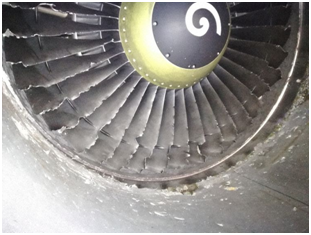
(The engine after the ingestion; photo taken from Avherald.com) - 4 April – Bratislava
Silk Way Airlines IlyushinIl 76, during the initial climb the engine nr. 4 ingested a bird; the crew burnt fuel and landed back about 3h20’ after take-off; - 6 April – Porto Santo (Portugal)
TAP A319, during the approach an engine ingested a bird; next leg cancelled; - 16 April – Charlotte (NC)
American Airlines A330, bird strike during the approach; - 18 April – Nashville (TN)
Southwest B737, during the initial climb the left engine ingested a bird and began to vibrate; immediate return 15’ after take-off; - 25 April – Al Hoceima (Morocco)
Royal Air Maroc ATR42, on very short final the crew decided to go around because the runway was occupied by birds; the aircraft however made ground contact with a hard touchdown before climbing out again; minor damage but next flight cancelled; - 28 April – Salt Lake City (UT)
Delta B737, on final struck a bird that caused damage to the left landing lights and left blood splatters; - 28 April – Des Moines (IA)
American A320, on final at 7 NM from the runway struck a large bird that caused damage to the radome; - 30 April – Madrid
Air Europa B737, on approach struck a flock of birds that caused several dents;

(The Air Europa 737 at the gate; phototaken from Avherald.com) - 1 May – Rio de Janeiro
Alitalia A330, during the initial climb hit a bird; in the absence of abnormal parameters the crew decided to continue the flight but about one hour later returned to Rio for landing; - 1 May - Antwerpen
VLM Airlines Slovenia Fokker F50, during the initial climb a bird impacted the windshield of the aircraft; the crew decided for an immediate return about 10 minutes after departure; the aircraft could not continue the flight; - 5 May – Dunedin (New Zealand)
Air New Zealand A320, during the initial climb hit a bird; the crew decided to continue the flight but later diverted to another airport; the aircraft could not continue the flight; - 5 May – Menorca
EasyJet A319, during the initial climb an engine ingested a bird and was damaged; the crew decided for an immediate return about 25’ minutes after departure; the aircraft could not continue the flight that was cancelled; - 6 May – Bilbao
Vueling A320, on final approach about 2.1nm before touchdown a griffon vulture(Gyps fulva)impacted the left engine causing debris of bird remains, feathers and engine metallic parts to fall into a property underneath the approach path. Some people reported they were outdoors in the garden when they heard a loud bang, looked up and spotted the aircraft followed by metallic debris, flesh and feather "raining" down into their property. One larger piece nearly fell onto their heads. Other ground observers reported about 6-7 vultures were circling the area; one of them was sucked into the engine.
http://www.preferente.com/noticias-de-turismo/partes-del-fuselaje-de-un-avion-y-del-buitre-que-lo-destrozo-caen-sobre-vecinos-de-bilbao-276134.html - 6 May – Uruapan (Mexico)
Volaris A320, at departure a bird impacted the radome of the aircraft; in the absence of any abnormal indications the crew continued the flight to destination; minor damage; - 7 May – Salt Lake City (UT)
Delta B767, during the final approach struck a bird; the aircraft could not fly its next leg; - 7 May – Harare (Zimbabwe)
Kenia Airways ERJ 190, bird strike at take off with ingestion; immediate return; two fan blades damaged and replaced; - 8 May – Kish Island (Iran)
Kish Air A321, during the takeoff run struck a gazelle (probably Gazellasubgutturosa)that caused a dent in the left engine inlet and damage to a number of fan blades; the take-off was rejected at a speed of 92 kts;
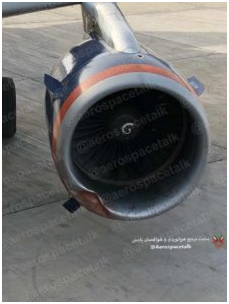
(The engine after the impact; photo taken from aviationsafari.com) - 12 May – Lahore (Pakistan)
PIA B777, on final approach after a diversion due to bad weather, the left engine ingested a bird; - 14 May – Leon (Mexico)
Volaris A320, during the approach a bird impacted the radome causing minor damage; - 15 May - Juazeiro do Norte
AviancaBrasil A320, during the initial climb an engine ingested a Caracara (Caracara plancus); immediate return;
http://diariodonordeste.verdesmares.com.br/cadernos/regional/colisao-com-carcara-cancela-voo-de-juazeiro-a-fortaleza-1.1939043 - 17 May – near Amsterdam
Lufthansa A340, during the climb to FL280 the crew felt vibrations at the engine nr. 1, dumped fuel over the North Sea and returned to Frankfurt; a post flight inspection revealed that the engine had ingested small birds without the crew becoming aware of the bird strike; - 18 May – Sibiu (Romania)
Wizzair A320, bird strike during the initial climb; the crew decided to return about 20’ after take-off; flight cancelled and aircraft under examination;
https://www.romaniajournal.ro/wizz-air-aircraft-bound-for-dortmund-makes-emergency-landing-in-sibiu - 24 May – Buffalo (NY)
Jetblue ERJ 190, bird strike at take-off; the no.1 engine apparently ingested one or more seagulls; the aircraft landed back 20’ later;
https://www.fox25boston.com/news/photos-boston-bound-flight-makes-emergency-landing-after-bird-strike/755692207 - 27 May – Bharatpur (Nepal)
Yeti BAe Jetstream 41, during the initial climb an engine ingested a bird prompting the crew to land back immediately; - 29 May – Mombasa (Kenya)
Condor B767, rejected take off following the ingestion of two crows into the left engine; local press reported erroneously an emergency landing;
https://www.nation.co.ke/counties/mombasa/Bird-strike-rocks-fight-at-Moi-International-Airport/1954178-4585192-ij4jpiz/index.html - 2 June – Lahore
PIA B777, on final approach the left engine ingested a bird; two fan blades damaged and replaced; - 2 June – Sialkot (Pakistan)
Emirates B777, during the approach an engine ingested a bird; next flight cancelled;
http://www.eyenewsnetwork.com/plane-prevented-accident-as-bird-hit-engine-at-sialkot - 2 June – Istanbul (Ataturk)
Azerbaijan Airlines A320, during the initial climb a bird hit the aircraft prompting the crew to land back 13’ after take-off;
http://abc.az/en/news/8014 - 3 June - Zhukovsky (Russia)
Pegas Fly B767, during the take-off run the crew observed a number of birds ahead shortly followed by a brief vibration of the right hand engine, all other parameters remained normal and the vibrations ceased again prompting the crew to continue the flight.A post flight inspection of the right hand engine revealed remains of a bird in the core of the engine and damage to a number of fan blades as well as sound absorbing panels. - 5 June – Amsterdam
KLM Cityhopper ERJ 175, suffered several strikes at take-off but the crew decided to continue the flight; 70’ later decided instead to return to Amsterdam; damage at one pitot tube reported; - 9 June – Eugene (OR)
Skywest ERJ175, bird strike on approach; unknown damage to the left engine; - 10 June – Copenhagen
Nordica CRJ700, at take-off struck a bird; in the absence of abnormal parameters the crew decided to continue the flight; a post flight inspection revealed damage that did not allow further flights; - 11 June – Orlando (FL)
Delta A320, during the approach struck a Turkey Buzzard (Cathartes aura) receiving substantial damage; - 13 June – Copenhagen
Easyjet A320, duringthe initial climb the right engine ingested a bird; immediate return 18’ after take-off; - 19 June – Ahmedabad
Indigo A320, multiple bird strike during the initial climb; return after 23’ from take-off; three dead pigeons found on the runway; - 19 June – Novosibirsk
Globus B737, a bird impacted the windshield during the initial climb prompting the crew to stop the climb, burn off fuel and return 2:50 hours after departure; - 20 June – Chennai (India)
Air India A321, after take-off the crew stopped the climb due to engine vibrations;
and landed back 20’ later.The airport reported feather and a few bent fan blades were found, however, no bird. The occurrence was thus declared a suspected bird strike. The airport complained that a lot of work including relocating waste dumps have been taken, however, there are still many meat and garbage stalls around the airport attracting birds. - 24 June – Tucson (AZ)
American Airlines A320, after take-off the crew stopped the climb requesting to land back advising they had a loud bang just behind the cockpit that they wanted to be checked out.
Later it was reported the aircaft received a bird strike, the damage is being assessed; - 27 June – Aberdeen
Eastern Airways BAe Jetstream 41, bird strike during the initial climb; the crew received a warning indication for one of the engines and decided to shut the engine down as a precaution and land back;
https://www.eveningexpress.co.uk/fp/news/local/emergency-declared-as-plane-forced-to-return-to-aberdeen-after-bird-strike1 - 28 June – Patna (India)
Air India A319, bird strike during the initial climb that promptedthe crew to land back 20’ after take-off; - 30 June – Rajkot (India)
JetKonnect B737, multiple bird strike on approach; return flight cancelled;
https://www.youtube.com/watch?v=jjOgckMB-ZE
Interesting case of a take-off clearance cancellation by the TWR operator that had observed an animal on the runway (January 7).
This is interesting because not every country attributes this responsibility to the controller, with the related obvious obligation to look out in order to identify the presence (also) of wildlife. Actually the Indian ATM manual states: ““In the event the aerodrome controller observes ... any obstruction .... such as animals or flock of birds…”
The word "observes"does not appear in the ATM manuals of other countries, nor even in the ICAO DOC 4444, which uses instead the more ambiguous term "becomes aware". India's regulation thus appears to be a commendable exercise of clarity for safety.
- 15 December 2017 – Toronto
Air Canada ERJ 190, during the take off a Snowy owl (Bubo scandiacus) struck the nose gear causing damage to theleft side landing gear aft door that did not allow to retract the gear; the crew declared emergency and landed back; - 6 January – Nantes
Travel Service Poland/Smartwings B737, during the initial climb flew through a flock of birds; the right engine ingested a number of birds prompting the crew to land back about 10 minutes after departure; a post flight inspection revealed 3 fan blades of the right engine were damaged;
https://www.ouest-france.fr/pays-de-la-loire/nantes-44000/nantes-un-boeing-737-percute-des-oiseaux-au-decollage-et-fait-demi-tour-5488693 - 7 January – Udaipur (India)
Jet Airways B737, rejected take off following the cancellation of their takeoff clearance by the TWR because a Jackal (Canisaurusindicus)had been spotted on the runway;
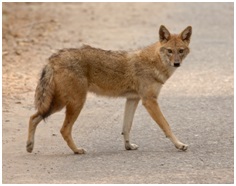
(Indian Jackal; Photo taken from Wikipedia)
- 17 January - Salt Lake City (UT)
Alaska Airlines B737, suffered a bird strike during the take-off run; the crew decided to continue the flight to destination (Seattle); the aircraft sustained unknown damage due to the bird strike and was grounded for maintenance; - 17 January – Nampula (Mozambico)
LAM LinhasAereas de Mocambique B737, rejected take off at high speed further a bird ingestion into the left engine - 19 January – Guwahati (India)
Air India A321, during the approach a bird struck the airframe probably causing a hole; the aircraft has been grounded for controls;
https://www.ndtv.com/india-news/air-india-flight-with-160-aboard-suffers-bird-hit-while-landing-in-guwahati-1802449 - 23 January – Algiers
Air Algerie A330, during the initial climb suffered a bird impact that caused abnormal indication from an engine; immediate return;
http://www.lexpressiondz.com/actualite/284672-un-avion-d-air-algerie-percute-des-oiseaux.html - 23 January – Edimburgh
Stobart Air ATR72, a bird strike after take off prompted the crew to land back; minor damage;
https://stv.tv/news/east-central/1406830-edinburgh-bound-flight-turns-back-after-hitting-bird - 24 January – Amsterdam
LATAM B777,was on final approach when a flock of birds flew into the way of the aircraft, one bird impacted the underside of the fuselage, another bird was ingested by the left hand engine;
http://www.youtube.com/watch?v=GigjNyv3OJ8 - 25 January – Lisbon
TAP A319, in the initial climb a bird impacted the windscreen while reduced power on the right engine was reported; immediate return about 15 minutes after departure; flight cancelled; - 29 January – Zagreb
Croatia Airlines A319, during the climb suffered a bird strike and returned for landing back about 40’ after departure; radome damaged; - 30 January – Islamabad
Airblue A321, after take-off ingested a bird into one of its engines; the crew continued the climb but then decided to return due to some abnormal engine indications about 35 minutes after departure; - 4 February – Sacramento (CA)
Southwest B737, during the initial climb a bird impacted the aircraft prompting the crew to land back 10’ later; minor damage;
http://sacramento.cbslocal.com/2018/02/04/bird-strike-causes-emergency-landing-at-sacramento-international-airport - 7 February – Ahmedabad
GoAir A320, during the initial climb a bird impacted the aircraft prompting the crew to land back 11’ later;
https://www.latestly.com/india/information/goair-720-ahmedabad-delhi-flight-suffers-bird-hit-today-flight-cancelled-all-passengers-safe-22090.html - 8 February – Johannesburg
Comair B737, during the initial climb suffered a strike with a medium sized bird, probably a Grey Hooded Gull (Chroicocephaluscirrocephalus); immediate return 20’ later;
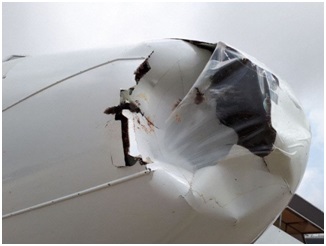
(The nose of the aircraft; photo taken from Avherald.com)
- 10 February – Portland (OR)
United A319, bird strike during the approach; - 16 February – between Dakar (Senegal) and Banjul (Gambia)
Brussels Airlines A330, after landing in Banjul a post flight inspection revealed the aircraft had received a bird strike during the flight and was unable to continue schedule; the flight was postponed by 49 hours and operated by another aircraft; - 18 February – Bhubaneswar (India)
Indigo A320, at take-off hit an owl and made a precautionary landing; no damage reported;
http://odishatv.in/odisha/body-slider/bhubaneswar-new-delhi-indigo-flight-makes-emergency-landing-after-bird-strike-277286 - 20 February – Zurich
Swiss Global Airlines Bombardier CS300, during the initial climb the crew reported they had hit a large bird during the departure roll, but they wanted to continue for now; later suspecting some engine damage landed back about 30 minutes after departure; flight cancelled; - 22 February – Nagpur (India)
Air India A320, during the final approach a bird impacted the right hand wing causing damage to the right hand flaps; the aircraft was unable to continue its schedule; - 22 February – Kish (Iran)
Kish Air Fokker 100, a bird strike at take-off is believed to have caused a later windshield crack and a diversion to the closest airport; - 23 February - Tuxtla Gutierrez (Messico)
Interjet A320, during the initial climb a bird struck the left engine prompting the crew to land back; - 27 February – Siargao (Philippines)
Skyjet Airlines Bae146, after landing suffered a runway excursion; the aircraft stopped in the grass, just past the runway end; the cause of the incident is said to be a bird strike; dead birds were reportedly found on the runway;
https://news.mb.com.ph/2018/02/27/jet-overshoots-runway-in-siargao-all-passengers-safe
https://aviation-safety.net/wikibase/wiki.php?id=206822 - 28 February – Izmir
Turkish Airlines B737, bird strike during the initial climb and crew decision to land back; flight cancelled; - 3 March – Nashville (TN)
Republic Airlines ERJ170, after take-off the crew reported they had a potential bird strike and requested a runway inspection while climbing out; despite the runway inspection had found debris, the crew decided to continue the flight to destination where damage was found caused by the bird strike; - 5 March – Tehran
Lufthansa B747, on final approach the inboard left hand engine ingested a bird; the aircraft was unable to depart for the return flight; - 10 March – Albuquerque (NM)
Delta B757, during the initial climb an engine ingested a bird and landed back; - 11 March – Atlanta (GA)
Delta MD90, during the initial climb the crew declared emergency further to a bird ingestion into the left engine that caused its failure; immediate return 30’ after departure; - 11 Marzo – Kumasi (Ghana)
- Africa World Airlines ERJ 145, on landing hit a bird; no damage reported;
http://citifmonline.com/2018/03/12/awa-renews-commitment-safe-flights-kumasi-incident - 15 March – Tampa (FL)
United A320, in the initial climb the crew reported they had taken a number of bird strikes during the take-off roll but wanted to continue their departure. About a minute later the crew reported they had a problem with the pitot #2 and wanted to return then decided to burn off fuel for about 3 hours and landed back. A runway inspection found and recovered multiple birds on the runway. - 15 March – Joao Pessoa (Brazil)
GOL B737, during the initial climb struck a bird and returned for landing; - 17 March – Baltimore (MD)
Southwest B737, on final at about 7 NM from the runway flew through a flock of birds receiving damage; - 22 March – Hong Kong
Air China B737, after landing the ground staff noticed the radome had received a hole of about 1 meter in diameter;blood stains suggested the aircraft may have suffered a bird strike. The crew had not reported any anomaly;
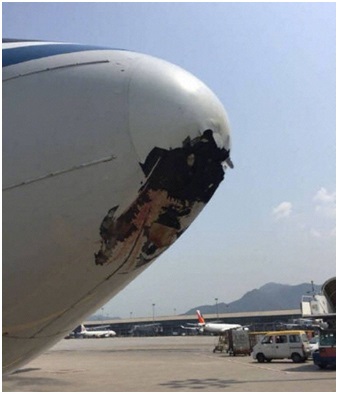
(The damaged radome; photo taken from Avherald.com)
- 25 March – Lahore
Serene Air B737, bird strike on final; the aircraft was unable to depart for the return flight; - 25 March – Los Angeles (CA)
Air China B777, suffered minor damage on landing due to a bird strike; the aircraft was unable to fly its next leg; - 27 March – Murcia
Easyjet A319, was lining up the runway for departure when the right engine ingested a number of birds resulting in an engine fire indication; the crew shut the engine down and discharged a fire bottle; - 29 March – Riberalta (Bolivia)
Amaszonas Linea Aerea SA227 Metro, during the takeoff roll a flock of birds impacted the right engine causing the crew to reject takeoff; the aircraft veered off the runway and came to a stop down a slope; no injuries are being reported;
https://www.eldeber.com.bo/bolivia/Avion-de-Amaszonas-se-accidenta-en-Riberalta-20180329-8268.html
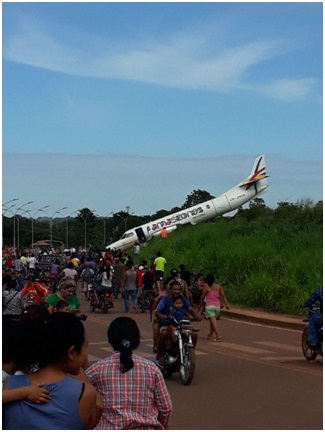
(The aircraft down the slope. Photo Fernando Galvan taken from eldeber.bo)
- 29 March – East Midlands
Ryanair B737, during the initial climb a bird impacted the aircraft causing damage to the windshield; the crew decided to land back about 10 minutes after departure; - 31 March – New York (JFK)
Delta A319, during the initial climb the left engine ingested a bird and began to vibrate; the crew shut the engine down and landed back 13’ after take-off;
http://abc7ny.com/delta-flight-lands-safely-at-jfk-airport-after-bird-strike/3286826

(The left engine after landing; photo Port Authority Police taken from Avherald.com)
The American NTSB released the factual report regarding the accident suffered by a Southwest B737 on 23.12.2013. The right engine ingested a number of Mallard Ducks (Anas platyrhynchos) and suffered an uncontained engine failure; there was evidence that a piece of high-speed debris had exited the engine through the outboard fan cowl near the fan plane.
Despite the closure of the Scarpino landfill, the problem of gulls at Genoa airport seems to persist. The November 5 event is similar to others of the past: a flock of gulls settled on the runway suddenly flew up in front of the taking-off aircraft. The most impressive precedent dates back to June 7, 1989, and gave rise to a long sequel of civil proceedings for compensation of the damage suffered by a TNT Bae 146.
In similar circumstances, it was less fortunate and suffered multiple impacts that led to the loss of an engine and the shutdown of two others immediately after the emergency landing. In 1997, however, it was the turn of an Antonov 124 to suffer the same fate but in the trial that followed the defendants managed to prove that the flock of seagulls were not settling on the runway but crossed it at low altitude in an unforeseen and unpredictable way. Despite these two famous court cases, once again we read about flocks of gulls settling on the ground near the runway without anyone, not the bird control, nor the Tower, nor anybody else, seeing and dispersing them.
- 27 September – Toronto
Air Canada ERJ190, during the initial climb through 1000 feet a bird impacted the right hand engine and causing minor damage; the crew landed back about 25’ later; - 1 October – Istanbul
THY A321, during the initial climb flew through a flock of birds and received a number of bird strikes prompting the crew to land back about 17’later; an engine inspection revealed damage;
- 1 October – Chandigarh (India)
Jet Airways B737, at the departure received a bird strike into one of the engines prompting the crew to continue the flight but diverting to Delhi, where the aircraft landed safely about 110’ later; reportedly a number of fan blades were found damaged; - 3 October – Sacramento (CA)
Southwest B737, on final approach a bird impacted the aircraft and caused minor damage; the aircraft was unable to continue its schedule however; - 3 October – Conklin (Christina Lake Airstrip, AB Canada)
Sunwest Dash 8, on landing collided with two deer that suddenly crossed the runway; the aircraft received minor damage to the radome, nose landing gear doors and left propeller;
https://globalnews.ca/news/3784390/northern-alberta-airport-shut-down-after-plane-hits-2-deer-on-runway/ - 9 October – Wilmington (NC)
PSA Airlines CRJ900, during the take-off run hit a coyote that caused damage to the nose gear; the aircraft landed back 30’ later and the flight was cancelled; - 9 October – Rockford (IL)
UPS B757, bird strike during the approach; minor damage to a landing light; - 11 October – Managua
American Airlines B737, during the take-off run a vulture impacted an engine causing its failure; immediate return 10’ later; the engine was severely damaged; - 12 October – Orlando (FL)
American Airlines A321, bird strike during the approach; minor damage; - 13 October – Mombasa (Kenya)
THY B737, during the initial climb an engine ingested a bird; the crew entered a hold to burn off fuel for about 2.5 hours and landed back about 2:50 hours after departure; - 14 October – Salt Lake City (UT)
Delta B737, was climbing through 6000 ft. when a bird impacted the nose of the aircraft; in the absence of any abnormal indications the crew continued the flight to destination (65’); damage to the radome; - 17 October – Leipzig
Eurowings A320, during the take-off run the crew rejected take-off at high speed; the aircraft was subsequently towed to the apron with the fire engines in trail but was able to depart about 2 hours later. According to some sources the take-off was rejected due to a bird strike; according to some eye witnesses the aircraft did not hit any birds instead, the TWR instructed the crew to abort the take-off, as a follow-me-driver observed a large flock of birds along the runway; - 19 October – Sao Paulo
LATAM Brazil B777, during the initial climb a bird impacted the right engine; the crew continued the climb up to the cruise flight level but then decided to return to Sao Paulo due to the bird strike, about 3 hours after departure;

(The right engine seen after the landing; photo taken from Avherald.com) - 20 October – Melbourne
Virgin Australia B737, during the climb the crew reported excessive left hand engine vibrations and decided to return to Melbourne advising that an eagle carrying a rabbit had just impacted their #1 engine; the aircraft landed back about 17 minutes after take-off; - 20 October – McAllen (TX)
Mesa Airlines CRJ900, on final approach a bird impacted the nose of the aircraft; the return flight was cancelled; minor damage to the nose cone; - 21 October – Fort Lauderdale (FL)
Southwest B737, after take-off the aircraft sustained a bird strike to the nose gear; in the absence of abnormal indications, the crew continued the flight until they decided to divert to Baltimore due to a hydraulic leak further to the bird strike onto the nose wheel hydraulic line;
- 23 October – Boston
JetBlue A320, after take-off the crew reported they had a bird strike at the left side that may have impacted the engine, it was probably a flock of sea gulls; during the procedures for completing the checklist and burning off fuel, the weather rapidly deteriorated in Boston and therefore the crew decided to divert to New York JFK. They advised everything appeared to be functioning normally, but maintained the emergency status and wanted emergency services follow them to the gate at JFK where they landed safely about 3:10 hours after departure; - 23 October – Goa (India)
Indigo A320, was accelerating for takeoff when a stray dog entered the runway prompting the crew to rejected takeoff at high speed (about 150 kts); the aircraft slowed safely but became disabled with a number of main tyres deflating due to brakes overheating; it was able to depart about 2:50 hours later; - 25 October – Seoul (Gimpo)
Asiana Airlines A321, in the initial climb the right engine ingested a bird prompting the crew to stop the climb and land back about 25 minutes after departure; several fan blades were damaged; - 26 October – Vienna
Austrian B767, during the initial climb the right engine ingested several birds; the crew initially continued to climb but later landed back after one hour; the flight was cancelled and the passengers were rebooked onto other flights; - 26 October – between Charlotte (NC) and Orlando (FL)
American Airlines A321,after an uneventful flight an inspection revealed that the aircraft sustained damage to the nose cone as result of a bird strike; - 26 October – Salt Lake City
Delta B757, during the approach an engine ingested a bird, briefly stalled and recovered; other aircraft reported seeing a flock of birds around 500 feet AGL; - 29 October – Minneapolis
Republic Airlines ERJ175, bird strike on final approach; the aircraft sustained minor damage to a windscreen wiper;
http://www.thehindu.com/news/national/tamil-nadu/peacock-hits-air-arabia-flight-while-landing-in-coimbatore-airport/article19944019.ece - 29 October – Coimbatore (India)
Air Arabia A320, during the approach a bird, reportedly a peacock, impacted the aircraft and penetrated the left wing root fairing; the aircraft was unable to depart for the return flight and remained on the ground for about 17 hours; - 31 October – Salt Lake City
Jetblue A320, in the initial climb the crew reported they had received a bird hit; after a first decision to continue the flight they landed back about 40’ later; reported damage to engines and leading edge of wings; - 2 November – Fukuoka
JAL B737, during the initial climb at 6000 feet suffered a bird ingestion into the left engine and landed back about 50 minutes after departure;
https://headlines.yahoo.co.jp/hl?a=20171102-00000060-jij-soci - 3 November – Wellington
Air New Zealand A320, rejected takeoff at high speed (about 100 knots) due a bird strike affecting an engine; the aircraft was able to depart about one hour after the rejected takeoff; - 4 November – Saint Louis (MO)
Southwest B737, on final a bird impacted an engine cowling causing minor damage; - 5 November – Des Moines (MI)
Endeavor Air CRJ900 on finalapproach the aircraft received a number of bird strikes and sustained substantial damage; - 5 November – Washington (DC)
Southwest B737, on approach received multiple bird strikes that caused damage to the radome and the wings; - 5 November, Rhodes
Ryanair B737, during the acceleration for takeoffthe crew observed a pack of dogs straying onto the runway but was unable to prevent the aircraft hitting one of them; the crew continued takeoff but landed back about 13 minutes after departure; since a control revealed no damage, the aircraft was released back to service; - 5 November – Genoa
Volotea B717, was accelerating for takeoff when a flock of sea gulls flew up from the runway; one of the birds impacted the right hand windshield prompting the crew to successfully reject takeoff at high speed (about 125 knots over ground); - 7 November – Salt Lake City (UT)
Jetblue A320, on final approach about 5nm before touchdown a bird impacted the right hand wing causing minor damage; - 11 November – Rio Branco (Brazil)
LATAM A321, during the initial climb a bird hit the aircraft; immediate return 22’ after take off; - 12 November - Vishakhapatnam (India)
Indigo A320, during the acceleration for takeoff, the crew observed a wild boar on the runway; being unable to deviate around the boar, the crew decided to rotate the aircraft early but to return to the airport to have the aircraft checked for any possible damage. Given the need to burn fuel, the aircraft landed back after one hour in flight; no damage reported further to the inspection; - 14 November – Alghero
Ryanair B737, during the approach an engine ingested a gull; next flight left with a 6,5 hour delay; http://notizie.alguer.it/n?id=128301 - 14 November – Miami (FL)
American Airlines A319, on approach a goose struck the aircraft and remained embedded in the radome; the aircraft remained on the ground for about 11 hours;

(The goose hanging off the radome – Photo by Planespottermania Taken from Avherald.com) - 15 November – Tampa (FL)
Southwest B737, bird strike at take-off; in the absence of any abnormal indications the crew continued the flight to destination about 2:20 hours later; on arrival an inspection revealed that the aircraft sustained damage to the horizontal stabilizer which made it unable to continue its schedule; - 15 November- Chennai (India)
an aircraft bound to Ahmedabad, type and airline unkown, suffered a bird strike at 5,500 ft. and was forced to land back; - 16 November – Chennai (India)
Indigo A320, at take off a bird struck the aircraft near the left hand engine prompting the crew to land back about 15’ minutes after departure;damage to a landing light and the leading edge of the wing; - 17 November – Philadelphia (PA)
American Airlines A321, during the initial climb the climb a bird impacted the aircraft; the crew burned off fuel and returned to the departure airport about 2:11 hours after departure; damage to fuselage and flap track; - 18 November - Kathmandu
Nepal Airlines A320, during the approach an eagle impacted the nose of the aircraft, momentarily blended with the nose section causing a large dent and dropped off;
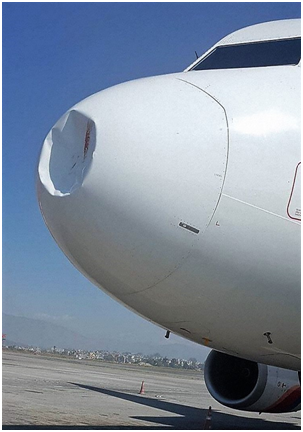
(L’A320 dopo l’atterraggio; foto di SusheelBhattarai tratta da Avherald.com) - 18 November - Delhi (India)
GoAir A320, during the initial climb a bird struck the aircraft prompting the crew to land back about 20’ minutes after departure; the nose of the aircraft sustained damage; - 19 November – Johannesburg
Mango B737, during the initial climb out a bird impacted the left hand engine inlet causing a dent; the crew decided to land back that happened 25’ after departure;
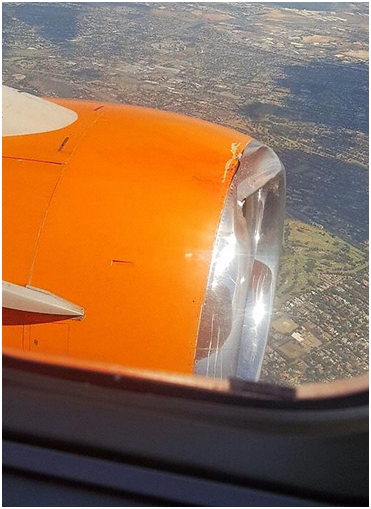
(The left engine. Photo by Sergio Davids taken from Avherald.com) - 19 November – Sacramento (CA)
Horizon Air DHC8, on approach a bird impacted the nose of the aircraft; the aircraft sustained substantial damage; - 22 November – San Francisco
United B737, was accelerating when the crew rejected takeoff at about 90 knots over ground due to a bird strike, probably with a turkey vulture; - 22 Novembre – San Francisco
Skywest ERJ175, during the initial climb an engine ingested a bird prompting the crew to land back about 10 minutes after departure; - 24 November – Coffs Harbour (Australia)
Sunstate Dash 8, on a final approach a bat impacted the aircraft; the aircraft was unable to continue its next sector; the impacted bat,belonging to the genus Pteropus,is locally known as Flying Foxand can have a wingspan up to 1,80mt. and a weigh up to 1,60 kg. - 29 November – Saint Petersburg
Aeroflot B737, on approach a bird impacted the radome and remained embedded; return flight cancelled; - 29 November – Sacramento (CA)
Southwest B737, during the initial climb suffered a bird strike at the right hand side; the right hand engine rolled back a little bit and the crew decided to land back 8’ after take off; - 1 December – Amsterdam
Transavia B737, bird strike on landing that does not allow the aircraft to fly the next leg; - 3 December – Torreon (Mexico)
VivaAerobus A320, during the approach flew through a flock of birds and suffered several impacts on the right engine; the aircraft however departed for the next scheduled flight and continued to operate on schedule throughout the rest of the day as well as the following day. Later on the Authority confirmed the right engine sustained unknown damage; the occurrence was rated a serious incident. - 4 December – Sacramento (CA)
Delta A320, during the initial climb at about 1000 ft. flew through a flock of birds and suffered several impacts; the crew decided to land back immediately declaring emergency.An inspection revealed evidence of ingestion in both engines and damage to the left wing slats and the radome; bird strikesigns were visible on both engines, the windshield, both wings, and the nose; bird carcasses of 11 Snow Geese (Ansercaerulescens) and 1 Ross’ Goose (Anserrossii)involved in the strike have been found later; - 6 December – Enschede (Olanda)
KLM, B747, at least three roe deer crossed the active runway immediately after theaircraft landing;
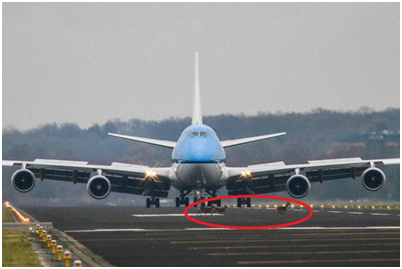
(The roe deer crossing the runway. Photo by SjoerdDrost taken from Avherald.com) - 9 December – Spokane (WA)
United B737, during the approach flew through a flock of birds and suffered multiple impacts; damage to the wings and the tail; - 10 December – Oakland (CA)
Fedex B767, bird strike during the approach; unknown damage; - 17 December – Istanbul (Ataturk)
THY A321, during the initial climb was struck by a bird and landed back 17’ after departure; - 22 December – Chennai
Air Asia A320, rejected take off at low speed further to the ingestion of a bird into the left engine; a number of fan blades found damaged; - 31 December – Hamburg
British Airways A319, on final a bird struck the aircraft destroying one of the pitot tubes; return flight cancelled;
The Indian Authority AAIB released the final report (http://dgca.gov.in/accident/reports/VT-SUC.pdf) regarding the investigation on the accident occurred on 4.12.2015 to the aircraft Bombardier Q 400 at the airport of Jabalpur.
During the night landing the aircraft hit a number of wild boars that had entered in the airport and were crossing the runway. The investigation highlighted several breaches in the perimeter wall as well as poor maintenance.
The Australian Authority released the final report (http://www.atsb.gov.au/media/5773811/ao-2015-007_final.pdf ) further to the investigation regarding the event of Jan 9 2015, occurred to a SAAB 340 aircraft on Moruya airport. After the landing, a flock of “galhas” took off from the grass west of the runway and impacted the aircraft. The crew carried out a visual examination but did not identify any damage. However, after the next flight the crew observed that the tip of one of the left propeller blades had detached.
Recently, has been brought to our attention the story of a Polish passenger who complained about the delay of her flight asking for the financial compensation as provided for by the European legislation. The airline claimed that the compensation was not due because the delay was caused by a bird strike, which constitutes an "extraordinary circumstance" that exonerates it from liability, as recently established by a sentence of the European Court of Justice
However, the passenger did not believe in the official version and did not lose heart. She therefore invoked the provision of the art. 5 para. 3 of the European Regulation 261/2004 which lays down an obligation for the carrier to prove the actual occurrence of the extraordinary circumstance, a bird strike in this case. Nothing’s that simple, because it would be enough to produce a copy of the bird strike reporting form that, at least in Europe, all carriers must fill to report the event to the Authority.
But this is where the problems start because the airline objected that such information should be considered confidential, and so did the competent authorities the passenger has so far addressed. To be honest, they do not deny that eventually an answer could be given but only at the end of long drawn-out procedures and at the discretion of the authority itself that might even refuse.
A first general consideration concerns the alleged extraordinariness of these events that frankly appears incomprehensible even by looking at public statistics, including ours. Bird strikes are, on the contrary, daily events and a delay due to these is the norm. Evidently, judges do not speak the same language used in aviation. And that would not be a novelty.
A second reflection concerns the protection of the passenger’s rights: opposing to those the protection of the airline privacy is even more incomprehensible because we really do not understand what is the good to be protected. A collision with a bird is not a shame to hide, nor an issue that concerns only certain areas or airports. It is a phenomenon unfortunately widely spread and affecting everyone.
It is therefore legitimate to suspect that, under the pretext of the privacy protection, some airlines hide behind the "extraordinary circumstance" other reasons of delay, this time dependent on the airline itself, which would instead result in financial compensation. In other words, to save money on the back of passengers. And this was certainly not the will of the European legislator or, we believe, of the Court of Justice. A well-known Italian politician once said that thinking the worst of someone is a sin, but most of the time you are spot on.
It’s time to begin fixing all this.
